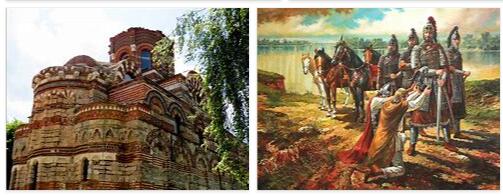Bulgaria History
The area of today’s Bulgaria was part of the historical Thrace landscape in ancient times. Of the Thracian tribes known from Greek written sources, the Triballians settled in western Bulgaria and eastern Serbia, the Serds in the area around Sofia, the Odryses around Stara Sagora and the Bessen in the eastern Rhodope Mountains. Since the 7th century BC The Thracians were culturally influenced and partially Hellenized by the Greek trading ports on the Black Sea and Aegean coasts. Around 450 BC The empire of the Odryses was formed in the territory of Bulgaria and was able to assert itself against the Greeks and Macedonians; neither Philip II of Macedonia, who owned the region in 342 BC. Chr. Conquered, even later his son Alexander the Great or the Diadoche Lysimachus in the early 3rd century BC BC brought the area under their full control. New immigrants were around 300 BC. Celtic ethnic groups with the center Tylos (on the Tundscha); they followed in the 2nd century BC. The Germanic Bastarnen and finally the Romans, the 29-28 BC. BC parts of Thrace conquered. In 45/46 AD the entire Thracian heartland finally came under Roman rule. The areas southeast of the line Sofia-Plovdiv were now on the province Thracia, the area north and west of this line with the province of Moesia (later divided several times, Moesia). Trajan secured the conquest through a Limes along the Danube and through the Dobrudscha (Trajan’s Wall). The population, now of very different origins, was partly Romanised. After the division of the Roman Empire in 395, the Thracian area came under the Eastern Roman (Byzantine) Empire. After devastation by the Goths and Huns, first forays by Proto-Bulgarian horsemen (since 491, several times in the first half of the 6th century) and the temporary supremacy of the Avars Slavs immigrated from the end of the 5th century and assimilated the local Thracian tribes. This ended the continuity of antiquity. After 675, the area came under the rule of the Turkic proto- Bulgarians, who at the end of the 6th century had been merged by Khan Kuvrat in the steppe zone around the Sea of Azov to form a tribal group “Greater Bulgaria”. After his death, part of it penetrated to the mouth of the Danube.
Bulgaria under Turkish rule (1396–1878)
According to educationvv, the conquered Bulgaria was subordinated to the Beglerbeg of Rumelia with the seat (until 1836) in Sofia and divided into five sanjaks (Widin, Nikopol, Silistra, Macedonia, Thrace). The population losses were to be compensated for by the settlement of Anatolian colonists and the semi-nomadic Jürüken (cattle breeders from Asia Minor). The local nobility was socially and economically leveled and replaced by Turkish spahis (timar system); the entire population was heavily taxed and encouraged to change beliefs (Pomaken), partly also violently Islamized. Since the higher clergy consisted almost exclusively of Phanariots and Greek had become the language of the liturgy, the clergy of the Bulgarian Orthodox Church was graced; the lower clergy and the monasteries developed into cells of national resistance. After the suppression of an uprising in northern Bulgaria (with the participation of Mirceas the Elder) in 1404, the Battle of Varna In 1444 and the capture of Constantinople by the Turks (1453) there was no longer any hope of a quick end to Turkish rule. With the exception of the economic contacts running through Ragusa, external relations were almost completely broken down. The endeavors of the Turkish Spahi warriors to transfer their service loans to large hereditary estates worsened the material situation of the Bulgarian peasants. The decline of the Ottoman Empire and the unsuccessful wars against the Habsburgs sparked local uprisings in Tarnowo (1598 and 1686), Gabrovo (1686), and Tschiprowez (1688 and 1737/38), which – just like the actions of the Heiducken - were bloodily knocked down. At the end of the 17th and beginning of the 18th centuries, many Bulgarians therefore sought refuge in the neighboring Danube principalities and in the Danube Monarchy.
The economic upswing that began in the 18th century with strong population growth favored the national revival, which was boosted by the »Slavic-Bulgarian history« of the Athos monk Paissi of Chilendar, which ended in 1762, and the Russo-Turkish War of 1768–74; In 1835 the first secular Bulgarian school was opened in Gabrovo. The freedom struggle of the Serbs (1804-17) and Greeks (1821-29), supported by Russia, as well as the inner-Ottoman reforms strengthened the national movement, which also supported the rebellious peasants (1835, 1841, 1850) in the struggle for a national Bulgarian church. Emigrants from Wallachia and Russia prepared the national uprising. In 1861 G. Rakowski organized the First Bulgarian Legion in Belgrade and in 1862 tried to organize the Heiducken to fight the Turks. In Bucharest, W. Levski and L. Karawelow founded a Bulgarian Revolutionary Central Committee based on the model of the Russian Narodniki and, in 1868, a Bulgarian Society. The establishment of the Bulgarian Exarchate in Constantinople (1870), despite many setbacks, further increased the desire for national freedom and the unification of the Bulgarian territories. The April uprising of 1876, at which a. C. Botew participated, could be bloodily suppressed by the Turks (»Bulgarian horror«), but the Russo-Turkish War in 1877/78 ended the Turkish rule (including participation of Bulgarian irregulars in the battle of Pleven and on the Shipka Pass).





